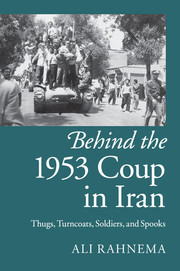Description
Behind the 1953 Coup in Iran
Thugs, Turncoats, Soldiers, and Spooks
Author: Rahnema Ali
This book reconstructs the events surrounding the Iranian coup d'état in 1953 that led to the overthrow of Mohammed Mosaddeq and his government.
Language: English
Subject for Behind the 1953 Coup in Iran:
Approximative price 31.58 €
In Print (Delivery period: 14 days).
Add to cart
Behind the 1953 Coup in Iran
Publication date: 09-2016
Support: Print on demand
Publication date: 09-2016
Support: Print on demand
Approximative price 94.05 €
In Print (Delivery period: 14 days).
Add to cart
Behind the 1953 Coup in Iran
Publication date: 11-2014
Support: Print on demand
Publication date: 11-2014
Support: Print on demand
Description
/li>Contents
/li>Biography
/li>
Ali Rahnema's work is a meticulous historical reconstruction of the Iranian coup d'état in 1953 that led to the overthrow of Mohammed Mosaddeq and his government. Mosaddeq's removal from power has probably attracted more attention than any other event occurring during his tenure because of the role of foreign involvement, the political, economic and social impact on Iran, and the long-term impact the ousting had on Iran-US relations. Drawing on American, British and Iranian sources, Rahnema closely examines the four-day period between the first failed coup and the second successful attempt, investigating in fine detail how the two coups were conceptualised, rationalised and executed by players on both the Anglo-American and Iranian sides. Through painstaking research into little-studied sources, Rahnema casts new light on how a small group of highly influential pro-Britain politicians and power brokers revisited the realities on the ground with the CIA operatives dispatched to Iran and how they recalibrated a new, and ultimately successful, operational plan.
Introduction: Mosaddeq's overthrow according to the shah; 1. The British reaction to Mosaddeq in power: 'Mossie Grabs Britain's Oil - But Navy to the Rescue' (Daily Express); 2. Mosaddeq's opposition strikes: testing tactics; 3. Who beckoned and who executed on 28 February (9 Esfand); 4. TPAJAX: company (CIA) commanders and firm (SIS) functionaries operationalising the coup; 5. The CIA-affiliated organisations: propaganda and combat; 6. The precision coup flops: back to the drawing board; 7. Second coup and capabilities of the military network; 8. A viable homespun coup; 9. The crucial last-minute preparations; 10. The second coup begins with the pincer movement of the thugs; 11. Coup agents occupying the city centre; 12. Attacking ministries and pro-Mosaddeq buildings; 13. The enigma of the tanks: betrayal or incompetence; 14. Mosaddeq overthrown; 15. Religious representatives and the coup; 16. Why did the second coup succeed?; 17. Mosaddeq's exit: legal transfer of power or coup d'état; Conclusion.
Ali Rahnema is Professor of Economics and director of the master's program in Middle East and Islamic studies at the American University of Paris. His publications include Superstition as Ideology in Iranian Politics (Cambridge, 2011) and An Islamic Utopian: A Political Biography of Ali Shariati, 2nd edition (2014).
© 2024 LAVOISIER S.A.S.




